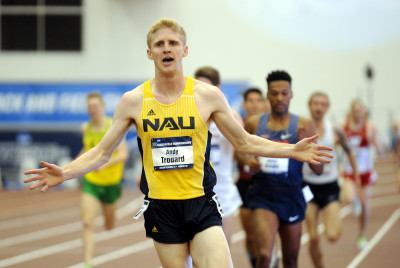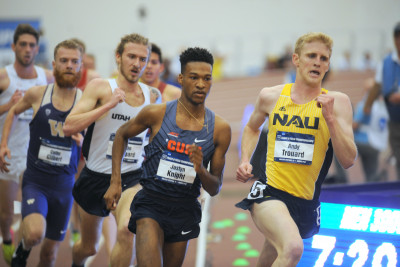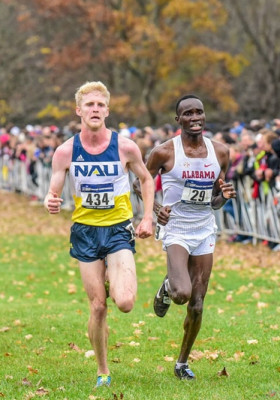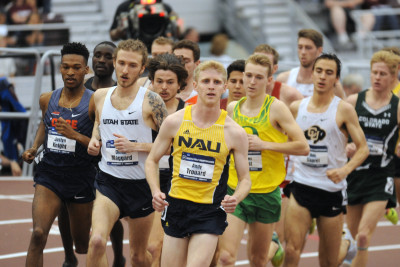How Andy Trouard Went From Northern Arizona’s #4 Man In Cross Country To A National Champion On The Track
Three months ago, Northern Arizona had three guys in the top 10 at NCAA XC. Andy Trouard wasn’t one of them. Now he’s the program’s first national champion on the track since David McNeill in 2010.
By Jonathan Gault
March 16, 2018
Updated editor’s note: For a podcast with Jon Gault & Coach Smith click here.
When Mike Smith arrived at Northern Arizona University in the fall of 2016, it didn’t take him long to figure out Andy Trouard was not a miler. The Lumberjacks’ head cross country coach, Eric Heins, was leaving after the season; Smith was his replacement. Since Heins was still handling the main coaching duties, that gave Smith a lot of time to observe. And when he looked at Trouard, he saw great acceleration and the strength to push to the finish line from a long way out, but he did not see a miler.
“One of the things I said to him was, ‘You can run a fantastic 3k,’” Smith said. “The best 3,000 and 5,000-meter runners have to have to have this kind of 1500 speed to close otherwise time and time again, you get someone who’s strong enough to be there late but is gonna get their doors blown off. And he has that [speed].”
Trouard saw himself differently. Healthy again after missing almost all of 2015 due to a nagging Achilles issue, Trouard had run 3:43 for 1500 meters that spring, good enough to qualify for his first NCAA championships on the track.
Rather than push against his athlete, Smith chose to let the subject go for the time being. He knows that a realization is more powerful when the athlete comes to it on their own.
“He knew what I was saying was true, but he wasn’t really ready to accept it,” Smith said. “And so I think the thing as a coach is, you don’t change the standard, or you don’t change telling them what’s true but you just wait for them to realize it…It was his choice from there but he’s not a 1500-meter runner. He never has been.”
***
A year and a half after Smith first sprang the idea, Trouard, who turns 24 next month (even for a redshirt senior, he’s old for his grade), fully embraces his identity as a 3k/5k guy. Of course, winning a national title will do that to a guy. Last weekend, at the NCAA Indoor Track & Field Championships in College Station, Texas, Trouard bounced back from a 5th-place finish in Friday night’s 5k to stun Syracuse star Justyn Knight in Saturday’s 3k, winning his first individual national title in 8:04.94 thanks to a 26.23 final 200.
Redefining himself is nothing new for Trouard. When Smith met him in the fall of 2016, Trouard viewed himself as a miler, but it might have been more accurate to call him something else: “future triathlete.” Trouard had spent a lot of time on the bike and in the pool while rehabbing his Achilles injury in 2015, and had reached out to Barb Lindquist, USA Triathlon’s Collegiate Recruitment Program Coordinator, about transitioning to the sport after his fourth year at NAU.
“I went into that season (2016-2017) thinking that whole summer, I’m just gonna train running, see what I can do, give it a last shot before I go to triathlon,” Trouard said.
Finally healthy and all-in on running, Trouard finished 37th at the NCAA Cross Country Championships that year to earn the first All-American honor of his career and help NAU to the first national title in school history in any sport. That convinced him to stick to running and come back for his redshirt senior year in 2017-18.
But before he was a 3k/5k guy, before he was a future triathlete, before he was a miler, Trouard wasn’t a runner at all. He grew up in Tucson, Arizona, playing soccer and swimming, where he placed second in the 50 freestyle at the Arizona state meet as a junior in addition to swimming legs on two state title-winning relay teams for Salpointe Catholic High School.
Trouard didn’t run track until his junior spring, but the sport quickly won him over. He won his very first race, running 4:35 for 1600 meters, and during the car ride home, while listening to Rush’s Limelight, he began plotting out his future.
I could actually be pretty good at this, Trouard thought to himself. This is exciting. I like this.
In his next race two weeks later, Trouard ran 4:21. He went on to win the 800, 1600, and 3200 at the Arizona Division II state meet and finished the year with a 1600 PR of 4:13. Trouard liked soccer and swimming, but he liked winning more. He went out for cross country in the fall, won another state title, and headed off to NAU in 2013 with stellar PRs of 1:53/4:08/8:51.
***
While it’s nice that Trouard found his event, moving up in distance from the 1500 doesn’t usually merit a feature on LetsRun.com. This story doesn’t get written without Trouard doing something extraordinary, and my assignment was essentially to answer the following question:
How the hell did a guy who had never scored at NCAAs on the track do this to Justyn Knight?
You know you’re good when you can stick your tongue out, trip on the rail because you stuck your tongue out, and still outkick a stud like Justyn Knight. #legend pic.twitter.com/dCgeUZdtVF
— Jonathan Gault (@jgault13) March 11, 2018
Last year, Trouard didn’t even qualify for the NCAA indoor meet, though there’s more to the story.
As a program, NAU chooses to emphasize cross country and outdoor track. As a result, Trouard only had one realistic shot to make the NCAA indoor meet in 2017.
“I said hey man, you can go to Iowa State, you can run a mile or a 3k and that’s all we’re going to do all season as far as trying to come down to sea level and really run a fast time,” Smith said. “And he chose the mile and he chose to go out in dead last and kick at the end…He ran a race that he won at Iowa State, I think he ran right around 4:00 (4:00.81), but there was no risk-taking on his part. There was nothing courageous there.”
Smith knows that sounds a little harsh, and is quick to point out that it’s easy to talk about leading a race and much harder to actually go out there and do it. But one of the tenets Smith tries to instill in his pupils is to be unafraid of leading — something that was on full display to anyone who watched last year’s NCAA Cross Country Championships. Developing as a runner is about lowering your personal best, but it’s also about becoming comfortable in any style of race.
“The athlete isn’t going to grow continuing to run the same race they’ve always been running,” Smith said.
Trouard views his unlikely ascent to national champion as a series of steps, and one of the biggest came last spring at the USATF Distance Classic in Los Angeles (better known as Oxy). Trouard had already redshirted in XC and indoor track, and decided to redshirt last year outdoors to give himself three full seasons in 2017-18. As a result, he found himself, a 13:56 guy at the time, facing a field of pros including 2016 Olympian Shadrack Kipchirchir. His preferred strategy of sit-and-kick was not going to work. These guys were too good.
So Smith told Trouard what he has many times in the past: commit to the middle. Meaning: Don’t back off when it gets hard. Keep grinding out laps in the middle of the race, even if it hurts, and trust that your kick will still be there at the end.
Sure enough, as the pace picked up in the middle of the race, Trouard found himself gapped. But he kept grinding.
“He’s in no man’s land on the track and he’s really just staying on the pace and committing to it,” Smith said. “And I was like, this is the missing piece.”
Trouard ran an enormous personal best of 13:36 to place 8th, a time that would have ranked him 4th in the NCAA last spring. He was no longer just a 1500 guy stepping up to the 5,000. In that race, Trouard proved to Smith that he was a true 5,000 runner.
Trouard moved on to the cross country season, and though he ran well in races where he could deploy his kick — he was NAU’s #1 man, third overall, at the loaded Wisconsin Invitational — Trouard wasn’t designed to run 10k cross country. At NCAAs, Trouard’s teammates Matt Baxter and Tyler Day turned the race into a true 10,000-meter race, and while it proved an effective strategy (Baxter and Day went 2-3 as NAU cruised to the team title), Trouard finished as NAU’s fourth man in 35th place.
“For a guy who is talking himself through every meter that’s past 1500 meters…that difference from 8k to 10k is a massive difference,” Smith said.
While Trouard only improved two spots from the year before, Smith was proud of his performance. Getting out hard and holding on runs counter to Trouard’s instincts, but that was the kind of race NAU needed to run to win, so Trouard sucked it up and did his job for his teammates.
“That’s what we try to teach them in cross country, that kind of selfless contribution for each other,” Smith said.
***
Trouard served notice midway through the 2018 indoor season that he would be a threat to win it all at NCAAs by outkicking reigning NCAA outdoor 5,000 champ Grant Fisher of Stanford to win the 3k at Iowa State on February 10. But that threat was diminished after Trouard ran the NCAA 5,000 final last Friday night. He finished 5th, almost two seconds behind champion Justyn Knight.
Guys who get blasted in the 5k almost never come back to win the 3k the next day; according to the USTFCCCA’s database, Trouard is only the second man in history to finish lower than 3rd in the 5k at NCAA indoors and come back to win the 3k the next day. The other, Stanford’s Elliott Heath, was 5th in the 5k in 2011 before storming back to win the 3k. Like Trouard, Heath was a big kicker, but he had a good reason for not winning the 5k — Iona’s Leonard Korir set a meet record of 13:26.01, dropping Heath well before the finish line. Knight’s winning time in 2018 was 14:14.47, the slowest at NCAAs since 1989. So where was the big kicker Trouard?
Chalk it up to a rookie mistake. Trouard had never run an NCAA final before on the track, and he was nervous; he didn’t want to get left behind once the kicking began.
“He kept trying to correct his position and [he’d] get swallowed up again,” Smith said. “And he had a lot of movement. And so when that thing really got going, he had exhausted a lot of physical and emotional resources trying to get good position for when the real race began.”
Rather than dwell on his failure, Trouard used the race as a learning experience. When he took to the track for the 3,000 final 22 hours later, he went to the lead immediately and held it for almost the entire race.
“I knew how tough it was to sit in a crowd and to pass people, even going 70-second quarter pace, it was still a challenge to pass people,” Trouard said. “I was just gonna get to the front and not let anyone past.”
On the back straight of the penultimate lap, Knight made a hard move but could not get around Trouard. He attacked twice more on the next two straightaways, and though he gained ground, he never had enough space to cut in front of Trouard before the turn. That was exactly how Smith had drawn it up when he told Trouard before the race to “win the straights.”
“If you can’t get around someone before that turn begins at the end of a straight, it is really, really hard to do otherwise,” Smith said. “The kind of acceleration you need, at late stages of the race, you’re gonna have to be in a really different place than the person you’re trying to pass to get around.
“And so really, you can break the track down into two 50-meter segments that have to be won. If you watch Andy’s race, Knight got past him actually, I think I counted two times Knight’s body actually was ahead of Andy’s body. But the turn begins and instantly Knight has further distance to travel at only a slightly faster velocity.”
Of course, Trouard still needed a killer close to win the race. He ran his final 200 meters in 26.23 seconds; by comparison, Ethiopia’s Yomif Kejelcha closed in 26.82 to win World Indoors a week earlier in a race that was 10 seconds slower (though, to be fair, Kejelcha began celebrating before the line and his final 800 of 1:52.00 was much faster than Trouard’s 1:56.72).
But it’s not as if Knight didn’t have a kick; he still closed in 27.04 (compared to 27.54 to win the 5,000). Maybe Trouard would still have beaten him if the roles were reversed, but the extra distance certainly didn’t help Knight.
Only one question remains. Why, with 50 meters remaining in a heated battle with the most feared runner in the NCAA, did Trouard decide to stick his tongue out on the final turn, causing him to misstep and almost blow his chance at a title?
“I was 7,950 meters into the racing at an NCAA championship (including the 5,000),” Trouard said. “I was pretty delusional, but I do remember looking at Smith. At that moment, for whatever reason in my mind, I knew I had the win. So I guess my emotions just kind of came out that way.”
It may sound crazy, but it’s not that different to when his coach arrived on campus two years ago and recognized his team’s top miler was destined to run longer events. When you know, you know.
Bonus Material: Podcast with NAU Coach Mike Smith: The Rise Of Andy Trouard, Why It’s Important to “Win The Straights” Indoors & Why You Should Embrace The Hurt In A 5K We liked our talk so much with Mike Smith we asked if we could make it a podcast. He said yes.





